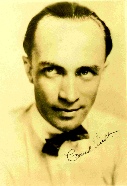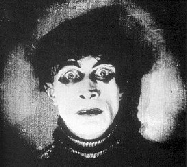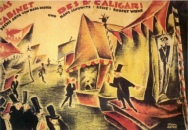
The Conrad Veidt Society
NOTE: For a complete list of actors and the production crew of this film, go to the Internet Movie Database here.
THE SYNOPSIS
Two men, dressed in dark suits, are seated on a bench in a garden. The elder man, with haunted eyes, has told his companion of the spirits that have hounded him from wife and home. Francis, the younger, watches a lady in white who walks by as if in a trance. ''That's my fiance,'' he says. ''What I have experienced with her is still stranger than what you have encountered. I will tell it to you.”
The annual fair at Holstenwall has just opened.
Dr. Caligari, hunched in a dark cloak, with a tall hat and dark circles of eyeglasses over a smiley mouth and stubble of beard, goes to the Town Clerk's office to obtain a permit to show his exhibit, a somnambulist. The Town Clerk treats the Doctor arrogantly, but finally indicates for his assistant to give the doctor a permit. The doctor stares after the retreating Town Clerk malevolently. He returns to the fair, where he has already set up his tent, and rings a bell to summon fairgoers to his exhibit. Cesare, the somnambulist!
The next day the Town Clerk is found murdered, stabbed to death. Young student Alan, tired of reading, decides to go to the fair*, and persuades his friend Francis to come with him. They pass by Caligari's tent while he is ringing the bell to announce the beginning of his 'show', and follow others into the tent. They crowd around a raised platform on which a wooden box stands. With great relish Caligari opens the box to reveal a tall, gaunt, young man dressed all in black, with dead white skin and eyes and lips lined in black. ''Awake, Cesare, your master commands!''
Slowly, very slowly, Cesare awakes. Eyesbrows twitch, eyelids clench, nostrils flare, lips stretch, almost in agony as the sleeper desperately tries to remain asleep. But his eyes open, wide and then wider, he raises his arms and steps slowly from the box.
Caligari invites spectators to come up to the platform. ''Cesare knows the past and sees the future.'' Despite Francis' protests, Alan comes forward and asks Cesare how long he has to live. Cesare stares at him. "Until dawn!" Alan is shocked and frightened. Francis leads him away as other people move forward, eager to ask Cesare their questions.
On the way home, with lamplighters going about to give illumination to the night, Francis and Alan see a placard announcing the murder of the Town Clerk. Then they see Jane walking by, and escort her home. By this time, the fair is over for the day. Caligari has a small house next to his tent, he emerges and carefully checks all around, then goes back in.
Alan and Francis part, after declaring their friendship will remain strong no matter which one of them Jane chooses as her husband. Hours later, Alan is sleeping peacefully. A tall, thin shadow is thrown upon the wall. Alan wakes and is so horrified by whatever it is he sees that he can only paw at the air in supplication. Then there are two shadows on the wall, struggling, a long thin knife is raised and stabs downwards
The next morning Alan's housekeeper rushes to Francis room and tells him of Alan's death. Francis, shocked and desolated, returns with the woman to Alan's house, then rushes to the police. He vows to find the perpetrator of these horrible crimes. (Perhaps he's a student of criminology, or the son of an official, for at all times the police give him all the information he desires).
Jane is waiting outside the wall that runs past her house when Alan arrives. She registers her shock and grief at his terrible news. Francis wants to talk to her father the doctor, and Jane brings him into the sitting room and fetches her father. Francis wants to talk to the somnambulist about his prediction. Jane's father agrees to go with him to get permission from the police.
Meanwhile, a shady character, with a long, thin knife, enters a house. Seconds later an elderly lady flings open a window and screams ''Help! Murder!'' The thief flees but is quickly apprehended by the townspeople, and brought to the police.
Caligari has mixed gruel for his somnambulist. He raises the sleeper to a sitting
position, but is interrupted by a knock on the door. Francis and the doctor demand
entrance, and the doctor shows his warrant. Caligari allows them to enter, but Cesare
remains asleep and Caligari refuses to waken him. Just then a newsvendor outside
proclaims that the multi-
At the police station, the thief, chained and alone in the middle of a cell, protests
that he is not the serial killer -
Jane waits at home for her father to return. He is gone longer than she had expected. Because she has heard Francis speak of Caligari, she goes to the fair. The grounds are empty, but when she reaches Caligari's tent she finds him there. (After feeding his creature he returns the box to the tent for the next day's performance). She tells him that her father had come to see Cesare. Caligari invites her to see Cesare. She enters the tent, and quite gleefully Caligari opens the box on his creature. Cesare wakes! Jane's reaction is all that he could have hoped, she flees in terror.
She recovers, however, in time to attend Alan's funeral that night, with Francis and her father. After the funeral, Francis settles down outside a window of Caligari's house to keep an eye on him. Caligari has Cesare's box in plain view, with one of the panels open so his sleeping figure can be seen.
However, Cesare is on his way to Jane's house, with a knife. Via rooftops and window, he oozes into her bedroom, advancing slowly with knife raised. His eyes fall on her beautiful face and he stops, transfixed. He drops the knife and extends his hand to caress her hair. Jane wakes and screams in fear. Panicking, Cesare grabs her and flees. Jane's brothers and father chase after him. Over the rooftop, down the lane, across a bridge runs Cesare, until, exhausted, he drops the girl. Her family gather round her, blocking the path from his pursuers, and he manages to elude them into the country side. But he's staggering now, worn out. He claws uselessly at the air to pull himself along, twists, falls, tumbles and lays motionless.
Francis hears the alarm and knows instinctively to go to Jane's house. Jane is recovering
in the sitting room while her father comforts her. Jane, regardless of Francis' assurances
that it could not have been Cesare, insists that it was. Francis rushes to the police
station to verify that the copy-
Later in the day, Francis goes back to the asylum and asks if they have a patient named Caligari. No. But does he want to see the director? Yes. Francis enters the director's office, sees Caligari seated behind the desk, and runs from the room in shock. He explains to the doctors that the asylum director is Caligari.
That night, while the director sleeps in his bungalow, Francis and the doctors investigate his office. They find his notebooks, and his diary. In flashback we see the director's joy when, after long waiting, a somnambulist is brought to the asylum. For years he's wished to duplicate the adventures of a 17th century Italian mystic named Caligari who terrorized the countryside with his somnambulist. Now he can carry out his experiments!
Breaking the flashack, a policeman enters and announces that they've found the sleeper's body out in the fields. All hurry to the site. Francis then orders the police to bring the body to the insane asylum. The police wait outside the door while Francis enters the director's office. ''You are Caligari!'' accuses Francis. He signals and the stretcher bearing Cesare's body is brought into the room. The director comes forward, and when he realizes his sleeper will never wake again he goes berserk. The doctors stuff his raving form into a straight jacket and plop him onto a bed. ''And from that day to this, he has never left his cell!''
The story is over. Francis and his spirit-
The director, with good posture, well-
QUOTES:
''I must know everything. I must penetrate the heart of his secret! I must become Caligari!''
''Du musst Caligari werden!''
PRODUCTION HISTORY
The framing sequence which shows the story of Caligari to be told by a lunatic was not part of the original film. The original story was a tale of lunatic authority and what happens to people who blindly follow orders. Caligari represented German government, Cesare was the German army that was unable to do anything of its own volition, and acted only under orders (at least until he fell in love with Jane). In order to defuse the film's statement, the prolgue and epilog were added later, to change the meaning of the film entirely. Fritz Lang, who at one point was in line to direct Caligari, is said to have suggested the framing sequence.
The two screenwriters for The Cabinet of Dr. Caligari were Czech Hans Janowitz and Austrian Carl Mayer. Janowitz was brought up in Prague before moving to Germany. He served during WWI as an officer in an infantry regiment, returned as a confirmed pacifist, animated by hatred of an authority which had sent millions of men to death. He settled in Berlin and there met Meyer.
Mayer was born in the Austrian provincial capital of Graz, where his father, a wealthy businessman, became addicted to gambling. After losing all of money by the time Carl was sixteen, he committed suicide. Carl cared for his three younger siblings. He was an embittered man, and underwent several psychiatric examinations during his WWI Army service (conceiving a hate for the doctor who administered the examinations).
The two men decided to write a screenplay which would show the dangers of bowing to absolute authority. After attending a fair, they had the idea for the location of the film. It took them six weeks to write the script.
Meyer went on to write several more successful screenplays. According to Lotte Eisner, Mayer left no novels or short stories at his death, his entire output was as a writer foir the cinema. ''He had an extraordinary visual gift. He immediately conceived actions in terms of images.''
The sets were designed and painted by three expressionist artists: Hermann Warm, walter Rohrig and Walter Reimann. They were affiliated with the Berlin Sturm group.
MY REVIEW
Conrad Veidt as Cesare does not have enough to do!!!
NOTES OF INTEREST
Veidt's film countdown
This was Conrad Veidt's 27th silent film.
From Theater to Screen
The actor who played Alan -
Symbolism in Caligari
The symbol of three. Caligari has three distinctive white streaks in his hair. His white gloves have three black lines running up to his fingers. There are three flights of stairs in the lunatic asylum. This indicates Caligari's at his position at the top of the hierarchy.
The versions of The Cabinent of Dr. Caligari
There are several versions of The Cabinet of Dr. Caligari available, and some of them have different scenes in different places. (Similar to the various restorations of Metropolis). I have the version copyright 1996 by Film Preservation Associates, and shown on AMC.
* Alan's first few scenes seem out of place in my copy of the film. Alan wants to go to the fair, and goes to Francis' house to persuade him to accompany him. It is on this same day that Caligari goes to the Town Clerk to get his permit. The next scene is the announcement that the Town Clerk has been murdered in the night. Scene cuts once more to Alan and Francis arriving at the fair for the first time (which would have been after the clerk was killed.
Who Killed Alan?
In the final scene, Alan is nowhere to be found among the asylum inmates. Can it be that it is F
We never see Cesare kill Alan. We see a shadow on the wall, that looks like Cesare, but might it be the thief, or Francis?
PHOTOS
Click here to go to the new Condrad Veidt Society Cabinet of Dr. Caligari Image Page.
BOOKS
Order the bookThe Haunted Screen, by Lotte Eisner here: HERE.
Order From Caligari to Hitler by Siegfried Kracauer: HERE.
DVDS/VHS
Order VHS videos of the Cabinet of Dr. Caligari HERE.
Order DVDs of the Cabinet of Dr. Caligari HERE.
CAN ANYONE ANSWER THIS?
Did tall, thin as a rake Conrad Veidt actually carry Lil Dagover with one arm for several feet, or did he use a lighter dummy dressed in Dagover's costume?
OTHER WEBSITES
By Barbara Peterson
The Cabinet of Caligari
THE PLAYERS
Werner Krause
Conrad Veidt
Friderich Feher
Lil Dagover
Hans Heinrich von Twardowski
Rudolph Klein-
Rudolph Lettinger
Dr. Caligari, who tours fairgrounds with his somnambulist.
Cesare, the man who has slept for 23 years.
Francis, a student, who along with best friend Alan, loves Jane
Jane Olsen
Alan, the victim of....whom?
A thief, who attempts a copy cat crime
Dr. Olson, father of Jane

